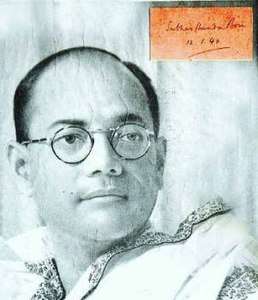Mukherjee Commission
The Mukherjee Commission, was one-man board constituted by the Government of India in 1999 to inquire into the death of Subhas Chandra Bose. Justice Manoj Kumar Mukherjee, a retired judge of the Supreme Court of India, was appointed to lead the inquiry.
The Mukherjee Commission was the third commission to inquire into the death of Bose. The two previous commissions, the Shah Nawaz Committee and Khosla Commission, had concluded that Subhas Chandra Bose died in a plane crash on 18 August 1945 in Japanese occupied Formosa (now Taiwan). After a seven-year inquiry, Justice Mukherjee concluded that Bose did not die in the plane crash. This part of the conclusion of the report were, however, rejected by the Government of India.[1]
Objectives of the commission
The purpose of the commission was to ascertain the following:
- Whether Subhas Chandra Bose is dead or alive?
- If he is dead, whether he died in the plane crash as alleged?
- Whether the ashes in the Japanese temple are ashes of Netaji?
- Whether he has died in any other manner at any other place and, if so, when and how?
- If he is alive, in respect of his whereabouts.
The commission is also the first to probe into the much publicized Soviet-connection. The basics of which are that Netaji Subhas Chandra Bose did indeed survive the end of the Second World War, and detained in a Siberian prison in the late 1950s. A former Russian General swore under oath to the commission, that he had seen a true Soviet-cabinet paper detailing and discussing a "living" Subhas Chandra Bose, one year after his supposed death.
Investigation
In 2001, the Commission was informed that a file from the so-called Netaji files, File No 12(226)56-PM, reportedly about the investigations into Bose's death, had in fact been destroyed in "routine course" by the Indian government in 1972.[2] The contents of this file were supposedly summarized in the Cabinet Secretariat but deputy secretary reported that there was no entry for that file.[2]
The government further was unable to find all the records from 1970 Khosla Commission.[2]
Findings
The Mukherjee Commission concluded that while Bose was presumed dead given the many years that had passed, he did not die in the plane crash in Taipei in 1945. Instead the commission proposed that the crash was a ruse to allow Bose to escape with the knowledge of the Taiwan and Japanese governments of the time. The Indian government was said to have learned of the escape through a Taiwanese report in 1956, which it chose to suppress. According to the commission the ashes kept in Tokyo's Renkōji Temple that are commonly believed to be Bose's, instead were the remains of Ichiro Okura, a Taiwanese army-man who died in August 1945. The commission did not find any evidence that Bhagwanji, a monk who lived in Faizabad, was in fact Bose in disguise.[3]
Rejection of Mukherjee Commission report by the Government of India
The Mukherjee Commission report was tabled in the Indian parliament on 17 May 2006. The report concluded that Bose did not die in the alleged air crash of 1945 and the ashes at the Renkoji temple are not his ashes. The report did not comment on his alleged stay in Russia after 1945 and called for further investigation into the matter. However, the report said that he could be presumed to be dead today.
On 17 May 2006, the Government of India reported that the Government have examined the Report submitted by the Commission on 8 November 2005 in detail and
observed that the Commission's inquiry was inconclusive in many ways, unable to provide a definitive finding on several issues and at variance with past well accepted Inquiry Commissions' findings in some critical areas; and have not agreed with the findings that -
(a) Netaji did not die in the plane crash; and (b) the ashes in the Renkoji Temple were not of Netaji.
The "MEMORANDUM OF ACTION TAKEN ON THE REPORT OF THE JUSTICE MUKHERJEE COMMISSION OF INQUIRY REGARDING THE ALLEGED DISAPPEARANCE OF NETAJI SUBHAS CHANDRA BOSE "[4]
"The Government have examined the report in detail and have regretfully accepted the conclusion that Netaji may not be with us any more and it is now not possible to comprehensively establish the circumstances of his death; but are not inclined to accept the findings of the Commission that Netaji Subhas Chandra Bose did not die in the plane crash because absence of documents does not conclusively disprove the overwhelming oral evidence of those who survived the crash, as testified before the Netaji Inquiry Committee (Shah Nawaz Committee), 1956 and Khosla Commission, 1972 - 74."
Justice Mukherjee's revelation
Justice Manoj Kumar Mukherjee stated in his report that the sanyasi of Faizabad (Bhagwanji) was not Bose as there was no clinching evidence to prove it. Nor did it confirm the Swamiji of Shaulmari Ashram in North Bengal was Netaji. However, the commission supports the view that Bose had not died in the plane crash in 1945.
See also
References
- ↑
- 1 2 3 Nag, Kingshuk (30 April 2016). "Govt razed key Netaji file: Declassified papers". Times of India.
- ↑ Nandini Guha; Rajeev Bhattacharyya; Nandini Guha; Rajeev Bhattacharyya (18 May 2006). "Netaji's dead but didn't die in crash, says report; long live the mystery". The Indian Express. Retrieved 7 November 2013.
- ↑ "Ministry of Home Affairs (MHA)/12014/8/06-NCB-II | Netaji Subhas Chandra Bose Papers". www.netajipapers.gov.in. Retrieved 2017-07-19.
